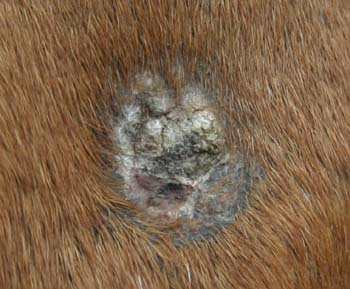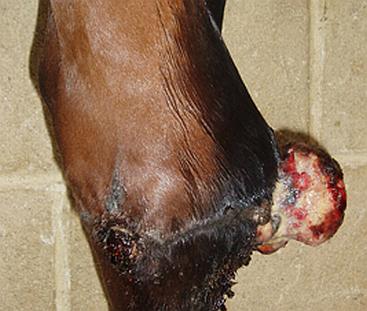| Home Medical Index | First Posted: Apr 12, 2010 Jan 21, 2020 | |
Equine Sarcoids, Angleberries (warts) or Papillomaby Debora Johnson  Images: Bullock's Vet Hospital (Website for this image is no longer available) Update/Study: Study/Whole genome scan identifies several chromosomal regions linked to equine sarcoids Update: "Mistletoe might be a timeless excuse for stealing a kiss at Christmas, but Swiss researchers have found a more practical and innovative use for the plant: treating equine sarcoids, the most common skin tumors in horses." Treatment of clinically diagnosed equine sarcoid with a mistletoe extract (Viscum album austriacus). I researched and wrote this article at the request of my friend, Colleen. A friend at her barn had a horse that had sarcoids. Note: "The breakthrough by the Glasgow scientists, funded with £159,000 from The Horse Trust, offers a potential treatment for horses affected by sarcoids. The researchers found that by inhibiting the activity of a particular viral protein within sarcoid cells, the amount of viral DNA in the cells reduced. This led to a reduction in the growth of the sarcoid cells and caused the cell to die by programmed cell-death (PCD). The researchers believe that PCD occurs because the sarcoid cells become reliant on the virus." About Sacrcoids:Sarcoids are benign tumors that do not spread throughout the body. They are small and raised and look like a wart. They can be in clusters or appear as a single tumor. The eyelids, underside of the horse's body, the distal limbs, penis and sheath are spots where sarcoids often appear. Sarcoids are locally invasive tumors of the skin. They may remain dormant or grow rapidly. Unfortunately, they are often quite aggressive. They must be treated and generally do not go away without treatment. Sarcoids can affect horses of any age, breed, gender or coat color and some horses are genetically predisposed to them. For example, Quarterhorses and Arabians seem to be more prone to sarcoids. They usually appear around 3 to 6 years of age. Generally they present as nubby gray surface with a cauliflower appearance or flatter and fleshier with the look of proud flesh. The question may be asked are sarcoids contagious. Presently there is no definitive answer to this question, however, a viral component is suspected. See the bolding under the Note below taken from the Vet Merck Manual. Sometimes sarcoids are referred to as angleberries, however, they are not angleberries. Angleberries are warts that are caused by the papilloma virus. Sarcoids are not warts. Also, angleberries usually appear on young horses who do not have a well developed immune system, as yet, or on ponies. Angleberries are not a problem other than they are unsightly. As the young horse matures the angleberries usually disappear on their own. Fibroblasts (A fibroblast is the most common type of cell found in connective tissue. Fibroblasts secrete collagen proteins that are used to maintain a structural framework for many tissues. They also play an important role in healing wounds) make up a sarcoid. There are basically six types of sarcoids:
"Equine sarcoids are the most frequently recognized neoplasm in horses. A viral etiology is suspected, and both papilloma virus and retrovirus particles have been identified on ultrastructural examination of sarcoids. In addition, cell-free extracts of bovine papilloma virus can induce a transient form of equine sarcoid when injected into horses. Evidence also suggests that sarcoids are transmissible by direct contact or via arthropod vectors or fomites, eg, contaminated brushes and needles. Sarcoids occur in horses, donkeys, or mules, most commonly in those <4 yr old. Although there is a tendency for sarcoids to develop in families, no breed, sex, or coat color predisposition has been defined. Sarcoids may be found anywhere on the body, and up to 84% of affected horses have multiple lesions. The most common site varies with geographic area; in the UK, the penis is the most commonly reported site, while in the northwest USA, the limbs are affected most frequently. Sarcoids are highly variable in appearance, and 4 manifestations are recognized: 1) verrucous, which may be confused with squamous papillomas or squamous cell carcinomas; 2) fibroblastic, which may be confused with granulation tissue or fibromas; 3) sessile or flat, which may be confused with flat warts (verruca plana); and 4) mixed verrucous and fibroblastic, which may be confused with fibropapillomas. They should be considered sarcomas of intermediate malignancy-they do not metastasize but are locally invasive. The fibroblastic and sessile forms are generally the most aggressive." The Merck Vet Manual/Sarcoids Considerations
Treatments
If it becomes necessary to treat sarcoids it is important to first determine what type or types of sarcoid your horse has. That is done by taking a biopsy. There are a number of different ways to treat sarcoids. The success rate can be as high as 90%, depending on the type of sarcoid. Unfortunately, sarcoids are persistent and tend to reoccur. The age of the horse, the use of the horse, the size of the tumor or tumors, the location of the sarcoid, and the financial cost are all considerations in the treatment of sarcoids. Surgical methods are used which include cryosurgery (the use of liquid nitrogen to freeze the sarcoid off), thermocautery (cauterization by a heated wire or point.), surgical removal, use of chemotherapy drugs injected locally into and around the sarcoid, and immunotherapy are all used. Stimulation of the horse's immune system is also part of the treatment for sarcoids. By using the horse's own immune system to recognize the unwanted tumor mass, the incidence of recurrence is minimized. The use of topical cream containing natural alkaloids and other ingredients is used to stimulate the immune system. The response is localized and the horse's body rejects the sarcoid tissue. Note:"Cryosurgery, after surgical debulking of larger lesions, is the treatment of choice. Two freeze-thaw cycles are generally used. A 1-year remission rate of ~90% has been reported. Also, nontreated lesions may regress spontaneously, although =50% of equine sarcoids recur after surgery. Radiation therapy using iridium may control up to 85% of equine sarcoids. This treatment is most commonly used when sarcoids develop in locations not amenable to cryosurgery or excision. Immunotherapy with inoculations of bacillus Calmette-Guérin (BCG) or cell wall extract of Mycobacterium bovis remains controversial; some reports indicate ~50% of tumors can be controlled with such immunomodulating therapies. Tumors so treated may take several months to regress. Treatment with flunixin meglumine and prednisolone 30 min before BCG inoculation is recommended. Lastly, BCG therapy should not be used when treated horses could be exposed to cattle because BCG can induce a positive tuberculin reaction in the latter." The Merck Vet Manual/Sarcoids For More Information: Electrochemotherapy Successful in Treating Equine SarcoidsSarcoid Development May Have Genetic Basis Bullock's Vet Hospital University of Liverpool The Merck Vet Manual/Sarcoids Sarcoid Factsheet |